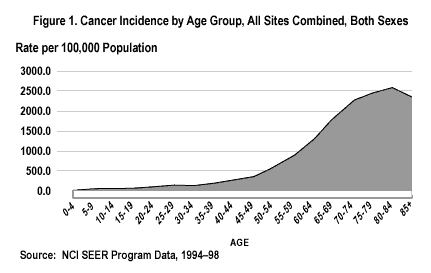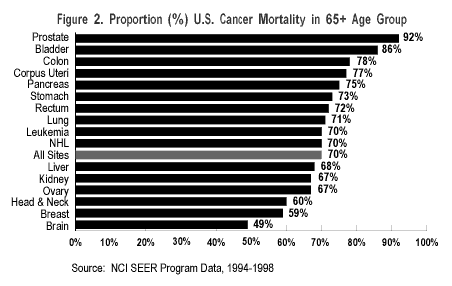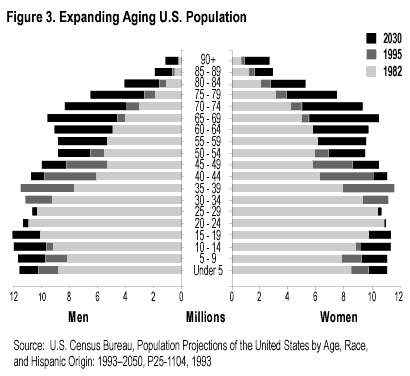The National Cancer Institute (NCI) cancer centers have the potential to play a prominent role in integrating aging and cancer research. The NCI-designated cancer centers represent a network of institutions that can be mobilized to advance the knowledge base on cancer in older persons across the research spectrum of prevention, early detection, diagnosis, treatment, and the biology of cancer. On August 10, 2000, National Institute on Aging (NIA) and NCI staff presented the idea of focusing on aging/cancer research to senior representatives from several cancer centers. Scientific areas of research and ways to marshal the broad expertise and talent that exist in the cancer centers were also discussed. After deciding that it would be productive to hold a workshop so that research ideas could be generated by a broader-base group of individuals, the participants in the August 10 meeting evolved into the NIA/NCI workshop planning group.
The NIA/NCI workshop was convened to invite input from representatives of the cancer centers on the topic of human cancer. The rationale for the workshop is based on the need to address the critical gap in knowledge on cancer in older persons, cancer incidence and mortality data, aging-related health issues, and the expanding aging population in the United States.
Cancer Statistics
Aging is a high risk factor for cancer. NCI Surveillance Epidemiology, and End Results (SEER) Program data, 1994–1998, reveal that nearly 60% of all incident tumors occur in persons aged 65 years and older. The age-adjusted incidence rate for persons aged 65 and older (2151.2 per 100,000 population) is ten times greater than the rate for persons aged under 65 (208.8 per 100,000 population).1 The rapid escalation of incidence rates is shown in Figure 1. Peak rates (ranging from 2233.5 to 2525.1 per 100,000 population) occur in persons aged 70 and older.
The age-adjusted cancer mortality rate (1068.3 per 100,000 population) for persons aged 65 and older is over 15 times greater than the rate for persons aged under 65 (67.3 per 100,000 population). The disproportionate burden of specific cancers in older Americans is shown in percentage proportions in Figure 2. Overall, 70% of all cancer deaths occur in persons aged 65 and over.1
Pancreas, stomach, rectum, lung, leukemia, non-Hodgkin’s lymphoma, liver, kidney, and ovarian cancers account for two-thirds to three-quarters of cancer deaths in persons aged 65 and older. Over 75% of cancer deaths are due to urinary bladder, colon, and corpus uterine cancers. Breast cancer, often thought to be a disease more prominent in premenopausal women, accounts for 59% of the mortality in women aged 65 and older. Prostate cancer mortality is in a class by itself with 92% of the deaths occurring in men aged 65 and older. Nearly 50% of brain cancer mortality and 60% of head and neck cancer deaths occur in persons aged 65 and older.

[ D ]

[ D ]
Comorbidity Burden and Cancer
A diagnosis of cancer in older persons is likely to be made in the context of preexisting health conditions (i.e., comorbidity). Investigators have indicated that four out of five persons aged 65 and older have one or more chronic conditions. Comorbidity and age-related disabilities add to the complexity of cancer treatment and care in the elderly.2
In a population-based colon cancer patient sample of males (N=799) and females (N=811) in three age groups, 55–64, 65–74, and 75 and older, NIA/NCI SEER Collaborative Study investigators found that the number of preexisting health conditions in cancer patients ranged from none to 14 and were a combination of extremely serious conditions, possible precursors to major illnesses, and nonfatal conditions.3 The number of conditions increased with advancing age. The prevalence of certain comorbidities increased with age for both women and men with 40% of each gender having five or more comorbidities. High prominence of hypertension, anemia (possibly tumor related), high impact heart problems, gastrointestinal (GI) problems, and arthritis were observed for both genders.3
A study on breast cancer by the same investigators illustrated the prevalence and age trends for selected comorbidities in postmenopausal women (aged 55–101 years, N=1800).4 The number of comorbidities ranged from none to 13. Among the comorbid conditions documented, which were similar to those indicated in the colon cancer study, a high number of previous primary cancers were seen in the patient sample (N=268). The proportion of previous primary cancers increased according to age group: 11% for patients aged 55–64, 14% for patients aged 65–74, and 20% for patients aged 75 and older.4
Data that indicate what happens when cancer is superimposed on the preexisting health problems of older patients are few. The varying health status and the physical and physiological substrates of the older individual needs to be incorporated into mainstream clinical research.
Aging of America
Our nation is aging. There is a growing recognition that the predicted expansion of the aging population in the United States will have far-reaching effects on the health status of our nation's citizens. There has been, and will continue to be, a substantial increase in the numbers and the proportion of Americans in the age group most vulnerable to cancer. Life expectancy at birth has increased from 48 years to 79.4 years for women and from 46 years to 73.6 years for men.5 Life expectancy at 65 years and 85 years has also increased. Persons who live to age 65 can expect to live an average of another 18 years, while persons who survive to age 85 years can expect to live an average of approximately 6 or more years.6

[ D ]

[ D ]
The first of the postwar baby boom cohort, born 1946–1964, will turn 55 years in 2001. In just three decades, an extraordinary change in the age structure of the United States is anticipated. By 2030, one in five persons (20% of the U.S. population) will be aged 65 or older, increasing from the present ratio of one in nine persons (12.8%). 7 The number of persons in the 65 and older age group will more than double, increasing from the current 34 million persons to 70 million persons. Moreover, within the older segment of the population, because of longer life expectancy and additional persons reaching older ages, there will be age shifts resulting in the 85 and older population more than doubling in size from 4.3 million persons to approximately 8.9 million persons.7 The age pyramid depicted in Figure 3 presents the estimated and projected age structure for selected years.8
The U.S. Bureau of Census has depicted the U.S. population as a roller coaster to show the effects of aging on the baby boom population over time.8 Seventy-five million persons were born in that period. This phenomenon should be factored into our cancer research efforts. As the total population continues to age and expand, so does the aging of the elderly. Age shifts within the segment of the population aged 65 and older are projected to increase the proportion of persons aged 85 and older from 4.3 million in 2000 to 8.8 million individuals in 2030.5
In this forum, participants had an opportunity to assist the NCI and the NIA in organizing research to advance the state of knowledge specific to cancer prevention, early detection, diagnosis, treatment and prognosis, biology, and enhancement of cancer survival. The vulnerability of older persons to cancer is unmistakable. As the nation ages, clinicians will be treating more older patients.
Information from a variety of disciplines and professions must converge, and new knowledge must be developed and applied at the aging/cancer research interface. In the workshop, a concise set of research priorities were identified to facilitate the integration of aging and cancer research that will establish a pathway to reduce the cancer burden for current and future older Americans.
References
- Ries LAG, Eisner MP, Kosary CL, Hankey BF, Miller BA, Clegg LX, Edwards BK (eds). SEER Cancer Statistics Review, 1973–1998. Bethesda, MD: National Institute of Health, 2000; NIH publication no. 00-2789.
- Fried LP, Wallace RB. The complexity of chronic illness in the elderly: from clinic to community. In: Wallace RB J ed. The epidemiologic study of the elderly. New York, New York: Oxford University Press, Inc., 1992: 10–19.
- Yancik R, Wesley MN, Ries LAG, Havlik RJ, Long S, Edwards BK, Yates JW. Comorbidity and age as predictors of risk for early mortality in male and female colon cancer patients: a population based study. Cancer 1998; 82(11): 2123–34.
- Yancik R, Wesley MN, Ries LAG, Havlik RJ, Edwards BK, Yates JW. Effect of age and comorbidity on treatment and early mortality in postmenopausal breast cancer patients aged 55 years and older. JAMA 2001; 285(7): 885–92.
- Kramarow E, Lentzner H, Rooks R, Weeks J, Saydah S. Health and Aging Chart Book, Health, United States, September 1999, DHHS publication no. (PHS) 99 1232-1, Life Expectancy, p30.
- Federal Interagency Forum on Aging Related Statistics. Older Americans 2000: key indicators of wellbeing. Available at: http://www.agingstats.gov. Accessed February, 2002.
- Day JC. Population projections of the United States by age, sex, race, and Hispanic origin: 1995–2050, U.S. Bureau of the Census, Current Population Reports, P25–1130. Washington DC: U.S. Government Printing Office, 1996.
- Day JC. Population projections of the United States by age, race, and Hispanic origin: 1993–2050, U.S. Bureau of the Census, Current Population Reports, P25–1104. Washington DC: U.S. Government Printing Office, 1993.
